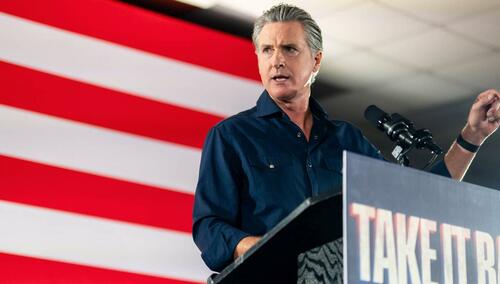Was The J6 "Insurrection" A Government-Sponsored Seditious Conspiracy?
Authored by James Howard Kunstler,
Cold Case Heats Up
"[The current FBI] was competent at cracking the case; [Christopher Wray's] was competent at corruption and obstructing it."
- Mike Benz
Do you have any idea what tapestry of corruption and crime is attached to the little thread of the J6 / DNC / RNC pipe bomber suspect arrested yesterday by the FBI? Consider this: suspect Brian Cole, Jr., is alive and probably talking, unlike, say, Jeffrey Epstein and Thomas Matthew Crooks in other matters of public interest. Let’s hope he is under FBI protection in custody, lest something. . . say. . . happen to him.
Dressed for government work?
As of early this morning, the country knows next to nothing else about Cole and what he was up to the night of Jan. 5, 2021.
The FBI has not even said how he is employed. But his photo shows a young man dressed for office work. . . he lives in a nice house in the DC suburbs of Virginia. . .and you might infer that he is, possibly, a federal government worker. Oh, and the FBI was unable to catch him through the whole four years of “Joe Biden?”
You can suppose at this point that the story of that four-year botched investigation will be a way bigger thing than the pipe bomber’s little prank itself.
It probably leads to the story of wholesale corruption in Christopher Wray’s FBI, and even more consequentially, to the realization that the so-called J6, 2021 “insurrection” was a government op from top to bottom, aimed at eradicating Trump and Trumpism.
First, what was supposed to happen in a joint session of Congress that day?
Answer: certification of electoral college votes in the 2020 election. What else was liable to happen that day? Answer: under the Electoral Count Act of 1887 (3 U.S.C. §§ 5–6, 15–18) — as amended, and by the rules laid out in the U.S. Constitution (Article II and the 12th Amendment) — objections to several states’ slates of electors were expected to be entertained, triggering debate and possible rejection of those states’ electors on the basis that the votes were not “lawfully certified” (under 3 U.S.C. § 6), or not “regularly given” (meaning the vote was marred by fraud, corruption, or violence). Any state’s electoral votes could be rejected if both the House and Senate voted by simple majority, after up to two hours of separate debate.
At mid-day, objections meeting the written requirement (one House member + one Senator) were filed for Arizona and Pennsylvania. The objection to the Arizona vote (Rep. Paul Gosar + Sen. Ted Cruz) was the first scheduled to be debated shortly after 1:00 p.m. It was not allowed to happen. Instead, Congress evacuated the chamber. When Congress returned at 8:00 p.m., votes objecting to Arizona and Pennsylvania slates failed and no others were taken up. Senators who previously had committed to debating the votes of several other swing states demurred, citing the breach of demonstrators into the Capitol. The full tally concluded at 3:44 in the morning, Jan 7, “Joe Biden” and Kamala Harris were certified as winners of the 2020 election.
Here are some things to know about the pipe bomb subplot in the J-6 story.
Kamala Harris, vice president-elect, still a sitting Senator (CA), was not in the chamber for the certification process. She arrived at the DNC headquarters some blocks away from the Capitol by motorcade at 11:30 a.m. and stayed until she was evacuated from the DNC at 1:14 p.m. Couple of questions about that? 1) did she not want to be present in the chamber at the momentous instant that her election as veep was certified? 2) Did she not have a duty to be present for voting on any of the procedure? Weird, a little bit. She has never explained what she was doing at the DNC that day.
Kamala Harris was in the DNC building when the pipe bomb was discovered there, around 1:07 p.m. The pipe bomb at the RNC had been discovered some 20 minutes prior, and it was the discovery of that bomb, at 12:44 p.m. that prompted the evacuation of the joint House / Senate session in Congress, not any breach of the Capitol building, which did not occur until 2:13, p.m., more than an hour later.
Now, to the FBI response to all this.
They quickly collected tons of closed-circuit video of a suspect planting these pipe bombs. The footage they released showed the suspect at a one-frame-per-second recording rate which, as Mike Benz points out, is a hundred times slower than any common gas station closed circuit camera nowadays. The FBI also doctored the recordings, specifically blurring out the section of the suspect’s face at one angle captured by a CC camera about eight meters away. The rectangular blur patch over his eyes can be clearly seen. How’d that happen?
The FBI also managed to botch every other aspect of the investigation into the act that actually triggered the evacuation of Congress that day — which was (repeat) not the breach of the Capitol building but the pipe bombs. In the months afterward, FBI Director Wray took agents off the case. He had in place as chief of the FBI’s Washington office an assistant director named Steven D’Antuono who had been in charge previously, as Detroit field chief, of the Gretchen Whitmer kidnapping case in which at least 12 confidential informants and three FBI agents were involved in what looked like an entrapment scheme. D’Antuono had demonstrated considerable skill in constructing skeezy FBI ops when he was put in charge of the DC office. The agency managed to lose the chain-of-custody for much of the evidence in the case, including originals of the videos, cell phone records, communications records between Capitol police, DC metropolitan police, Secret Service, and the FBI, and more.
So, the pipe bomber has been a cold case lo these many years. And now we’re informed as of yesterday’s FBI / DOJ press conference, that the FBI under Director Patel cracked the case using only information and evidence already in the FBI files. So, get this: there must be a record of exactly which agents were on the pipe bomber case those four years under Christopher Wray. There must be a record of who, by name, was in charge of chains-of-custody for all that evidence. And there must be a record of the senior agents and deputy directors who oversaw all their activities, all the way up to Director Wray. Why would they not be subject to charges of obstruction of justice?
All of this is just the pipe bomber subplot of the J6 story. There remains the weird business with then House Speaker Nancy Pelosi and her failure to request national guard protection at the US Capitol that day. And there remains the question of how many agents, assets, and confidential informants the FBI had in-place at the Capitol on J6, 2021, including Antifa members, and which actions, including the breach inside the building, they instigated. Then there is the question of the House J6 committee, how it was constructed with the help of lawfare ninja Norm Eisen, and how it deliberately destroyed all the evidence it collected over the months of its existence.
Be prepared to learn how the J6 “insurrection” was a government-sponsored seditious conspiracy and then ponder who, by name, will be held responsible for it. That’s the tapestry that Brian Cole, Jr.’s little thread leads to.
Shout out to Mike Benz for his nearly four-hour discussion about the pipe bomber case on “X”.
https://ift.tt/lCDSdsP
from ZeroHedge News https://ift.tt/lCDSdsP
via IFTTT













